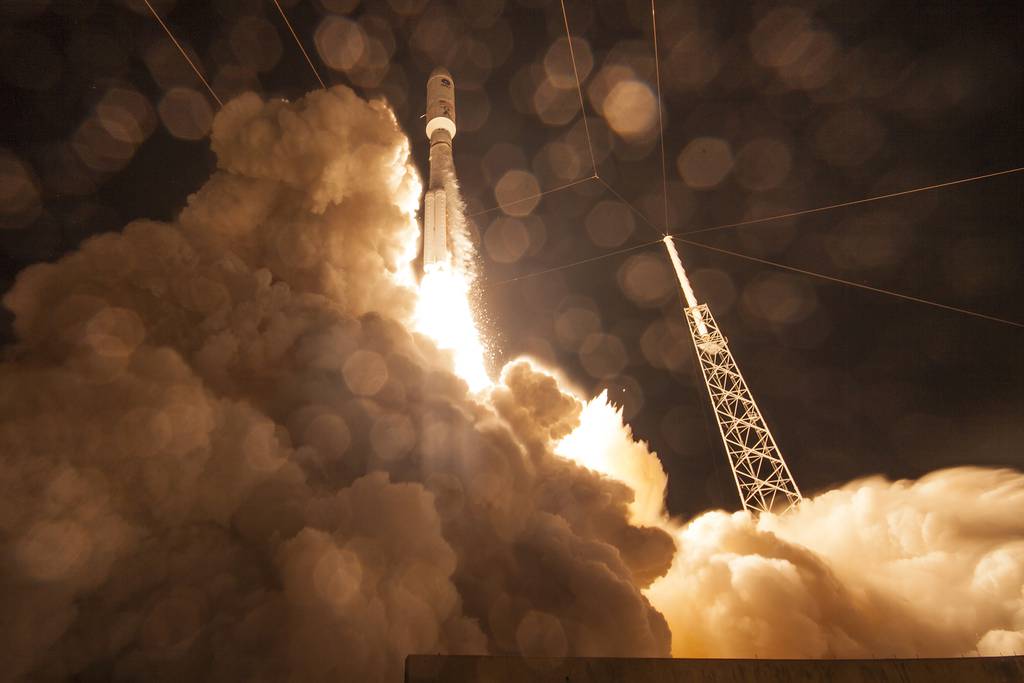WASHINGTON — The U.S. Space Force expects to release a solicitation early next year for two Mobile User Objective System satellites, a multibillion effort meant to ensure military users have access to secure communications.
The service operates four active MUOS spacecraft and one on-orbit spare, all built by Lockheed Martin through a program that originated with the Navy, but transferred to the Space Force in March. The narrowband communication satellites operate in the 300MHz to 3GHz frequency range, making them less vulnerable to severe weather conditions and ideal for secure information transfer.
Barbara Baker, deputy program executive officer for Space Systems Command’s Military Satellite Communications and Positioning, Navigation and Timing Directorate, confirmed this week to C4ISRNET the service plans to request bids from companies for early risk-reduction and design work in early 2023.
The Space Force revealed in its fiscal 2023 budget request it plans to spend $3.7 billion to develop two more satellites that will launch by the end of the decade. That includes $165 million in fiscal 2023 and $1.4 billion over the next five years.
The acquisition is meant to extend the life of the constellation and is an outgrowth of a series of studies initiated by the Navy and carried forward by the Space Force. Lockheed, Northrop Grumman and Boeing —three of the top four military contractors globally, according to a 2022 Defense News analysis — all participated in those studies. The Space Force may choose more than one company for the first phase, which would be followed by a competition between those firms.
Baker said in an Oct. 14 email the service hasn’t set a timeline for a contract award. She said the satellites will have common user interfaces with the other systems on orbit and may carry new capabilities, but did not provide details.
“The satellites . . . will meet or exceed the current system performance requirements and have compatible interfaces to ensure seamless integration with the MUOS ground systems and continuity of operations,” she said.
Today’s MUOS satellites, which replaced the Ultra High Frequency Follow-on system, carry two payloads — one to maintain the legacy UHF network and a second that provides a new Wideband Code Division Multiple Access capability. The system is designed to provide 10 times the capacity of its predecessor.
Justin Keller, director of advanced programs and military space at Lockheed, told C4ISRNET Oct. 9 the company attended an industry day in September with the Space Force and other prospective vendors. The message from the service, he said, is that they want a low-risk solution that prioritizes schedule.
“Their No. 1 focus is schedule and low risk, and we’re 100% behind that,” he said. “I think the government, the Space Force, has laid out a really good plan to get us there.”
Prioritizing resilience
Along with schedule and risk management, the Space Force is prioritizing resilience as it makes near-term upgrades to systems like MUOS and as it sets plans for future versions of these constellations. The service is slated to begin analysis next year to consider its long-term narrowband communication needs.
Keller noted that for satellites like these that weren’t designed to be resistant to cyber threats and enemy jamming, balancing these demands can be a challenge. The Space Force hasn’t revealed what limited resilience measures it may want for the sixth and seventh MUOS spacecraft because those capabilities are often classified.
“They’re hoping to address those [threats] that will not interfere with their schedule,” he said. “We’ve done a lot of work on that.”
As the Space Force moves forward with plans to buy more MUOS satellites, lawmakers have raised concerns about the performance of the current capability. The program experienced significant fielding delays, particularly with the terminals and equipment that allow users to connect to the system. A 2021 Government Accountability Office report found personnel on the ground were not able to take full advantage of the satellite’s more advanced features.
In the Senate’s version of the fiscal 2023 defense policy bill, lawmakers referenced GAO’s work and called for a demonstration of a “narrowband gapfiller” capability by January 2025. The Senate Armed Services Committee also wants a report on the status of the MUOS follow-on work.
Keller noted that while the program has experienced setbacks, feedback from users has improved as more terminals are fielded.
“Now that they have the terminals, everything we’ve heard is universal praise on the particular quality of the service compared to what they had before,” he said.
Courtney Albon is C4ISRNET’s space and emerging technology reporter. She has covered the U.S. military since 2012, with a focus on the Air Force and Space Force. She has reported on some of the Defense Department’s most significant acquisition, budget and policy challenges.








